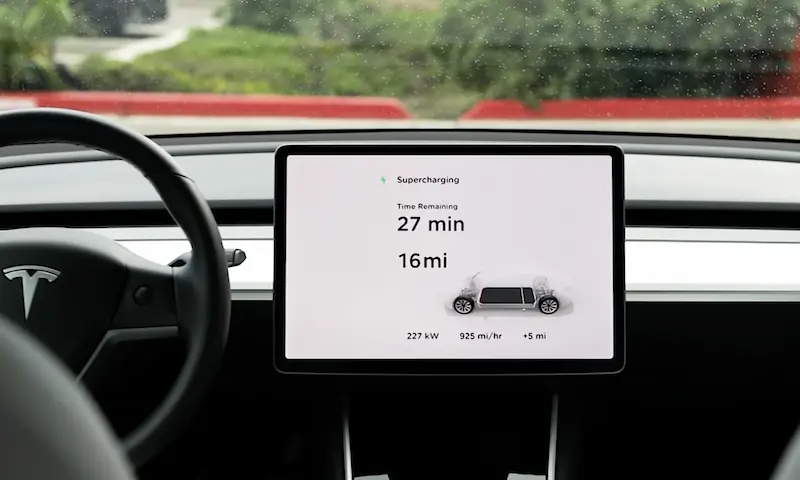Ever noticed that pesky warning light on your Tesla dashboard? The one showing tire pressure issues can be more than just an annoyance—it could indicate a real problem with your Tesla tire pressure monitoring system. When this system fails, it’s not just about a blinking light; it’s about your safety on the road.
Let’s dive into everything you need to know about Tesla TPMS faults, from common causes to DIY fixes and when it’s time to call Tesla Service.
What Is Tesla’s TPMS and How Does It Work?
Tesla vehicles use a direct Tire Pressure Monitoring System with Bluetooth Low Energy (BLE) sensors mounted inside each wheel. Unlike older systems, Tesla’s TPMS provides real-time pressure and temperature readings for each individual tire.
The system works by:
- Transmitting data from sensors to your vehicle’s computer
- Displaying pressure readings on your touchscreen
- Alerting you when pressure drops below recommended levels (typically 42-45 PSI)
- Automatically relearning sensor positions after tire rotations or replacements
What makes Tesla’s system unique is its self-learning capability. After tire changes, the system can automatically recognize and recalibrate sensors during drives exceeding 15 mph for about 15-20 minutes, without requiring manual reprogramming in most situations.
Common Causes of Tesla TPMS Faults
1. Sensor Battery Failure
The most frequent culprit behind TPMS faults is sensor battery depletion. These batteries have some important characteristics:
- Non-replaceable design (entire sensor must be replaced)
- Expected lifespan of 5-10 years
- Can fail earlier in cold climates or with seasonal wheel sets
- May become unresponsive below 50°F (10°C)
Some owners report failures as early as 3 years, particularly with wheels that aren’t used year-round.
2. Software-Related Issues
Tesla’s over-the-air updates occasionally introduce TPMS problems:
A significant issue occurred in 2024 when update 2024.38.3 altered how TPMS warnings work, causing the warning light to reset between drive cycles instead of staying on during malfunctions. This violated federal safety standards and prompted NHTSA recall 24V-935 affecting nearly 700,000 vehicles.
The software update changed sensor reporting frequency from 60-minute to 30-minute intervals, causing older sensors to trigger false warnings even when physically functional.
3. Physical Sensor Damage
Physical damage to sensors can occur during:
- Tire installations/removals
- Impacts with potholes or curbs
- Exposure to corrosive road chemicals
4. Incorrect Sensor Registration
After tire changes or rotations, sensors sometimes fail to register correctly with the vehicle’s system, particularly when:
- Aftermarket sensors are used
- The vehicle doesn’t complete a proper learning drive cycle
- The vehicle software is outdated
How to Diagnose a Tesla TPMS Fault
When you see the dreaded “Tire Pressure Monitoring System Fault” message, follow these steps:
Check Your Tires First
Before assuming it’s a system fault:
- Visually inspect all tires for damage or obvious low pressure
- Use a reliable pressure gauge to check all tires (including spare if applicable)
- Inflate tires to the recommended pressure (found on the driver’s doorjamb sticker)
Read the Specific Warning Message
Tesla’s warnings can reveal different problems:
- “TPMS Needs Service” – Often indicates sensor battery failure
- “TPMS Sensor Fault” – Could be a communication issue
- “VCSEC_a222” – Typically related to software issues with sensor communication
Use the Tesla App for Initial Diagnosis
The Tesla app can show you:
- Current pressure readings for each tire
- Which specific sensor(s) might be failing
- Whether the issue is intermittent or constant
How to Reset Your Tesla TPMS
For minor glitches, a reset might solve the problem:
Method 1: Basic Reset Through Touchscreen
- Touch “Controls” on your Tesla touchscreen
- Select “Service”
- Choose “Reset TPMS”
- Drive above 15 mph for at least 10 minutes to complete the relearning process
Method 2: Hard Reset for Persistent Issues
If the basic reset doesn’t work:
- Pull over safely and put the car in Park
- Hold down both scroll wheels on the steering wheel until the screen goes blank
- Let the system reboot completely
- Try the basic TPMS reset procedure again
After-Reset Drive Cycle
For best results after any reset:
- Drive at speeds above 25 mph
- Continue for at least 10-20 minutes
- Make several gentle turns in both directions
- Avoid hard braking or rapid acceleration
According to Tesla’s official manual, this driving pattern helps the system properly identify each sensor’s location.
DIY Solutions for Tesla TPMS Faults
For the hands-on Tesla owner, here are some approaches to fixing TPMS issues:
Software Update Fixes
If your TPMS fault appeared after a recent software update:
- Check for a newer update that might contain fixes
- Enable “Advanced” mode in your software update settings
- Connect to strong Wi-Fi to speed up update delivery
The critical fix for the 2024.38.x TPMS issue was released in version 2024.44.x, according to Tesla’s support page.
Proper Inflation Techniques
Maintain proper tire pressure with these tips:
- Check pressure when tires are “cold” (before driving or at least 3 hours after)
- Follow Tesla’s recommended pressures (usually 42-45 PSI)
- In very cold weather, increase pressure by 3-5 PSI to compensate for thermal contraction
- Recheck after significant temperature changes
Seasonal Considerations
If you live in an area with extreme weather changes:
- Expect more frequent TPMS alerts during sudden temperature drops
- Allow your vehicle to warm up before driving in freezing temperatures
- Consider slightly higher tire pressure during winter months
When to Replace Tesla TPMS Sensors
Signs Your Sensors Need Replacement
It’s probably time for new sensors if:
- Your vehicle is over 5 years old with original sensors
- The “TPMS Needs Service” message persists after resets
- You see intermittent sensor readings that come and go
- One or more tires consistently show “—” instead of a reading
OEM vs. Aftermarket Sensor Options
You have choices when replacing sensors:
| Sensor Type | Average Cost | Pros | Cons |
|---|---|---|---|
| Tesla OEM | $180-240 per sensor | Guaranteed compatibility, Often includes installation | Most expensive option, May require appointment wait time |
| Continental/Baolong OEM (Tesla supplier) | $80-110 per sensor (parts only) | Same quality as Tesla-branded sensors, Better price | Requires separate installation cost, May need Tesla visit for programming |
| Aftermarket | $50-80 per sensor | Lowest price, Widely available | Potential compatibility issues, May require multiple programming attempts |
Installation Options
You can get your sensors replaced at:
- Tesla Service Center – Most expensive but guaranteed compatible
- Tire shops with Tesla experience – Call ahead to confirm capability
- Mobile tire services – Some specialized in Teslas
Many owners report that independent shops can install OEM sensors purchased separately, saving considerable money over Tesla Service Center prices.
Preventing Future Tesla TPMS Faults
Regular Maintenance Practices
Avoid future TPMS headaches with these habits:
- Check tire pressure monthly using a quality gauge
- Keep an eye on sensor battery age (replace proactively after 5 years)
- During tire rotations, ensure proper sensor relearning procedures
- Consider replacing all sensors simultaneously once one fails (if your vehicle is 5+ years old)
Software Update Strategy
To prevent software-induced TPMS problems:
- Check Tesla forums before installing major updates
- Wait 7-10 days after a new release before installing
- If problems emerge after an update, request a rollback from Tesla service
Weather-Related Precautions
For temperature-related TPMS issues:
- Expect more alerts during first cold snaps of fall/winter
- In extreme cold regions, consider slightly higher tire pressures
- Allow pressure readings to normalize after temperature changes before becoming concerned
Real-World Experiences With Tesla TPMS Faults
Model-Specific Considerations
Different Tesla models have shown varying TPMS reliability:
Model 3/Y:
- Uses newer BLE sensors with generally better reliability
- More susceptible to software-related issues
- Typical sensor lifespan of 5-8 years
Model S/X (pre-2021 refresh):
- Uses older sensor technology
- More prone to battery depletion
- May require more complex relearning procedure
Cybertruck:
- Uses latest sensor design
- Included in recent software-related recalls
- Limited long-term reliability data
Cost Considerations
The financial impact of TPMS repairs varies widely:
- DIY sensor replacement: ~$400-600 for all four wheels (parts only)
- Tesla Service Center replacement: ~$900-1,200 all-inclusive
- Independent shop with OEM parts: ~$600-800 all-inclusive
Many owners report saving 30-40% using independent shops with OEM sensors compared to Tesla Service Centers.
TPMS and Your Tesla’s Safety
Don’t underestimate the importance of functioning TPMS:
Properly inflated tires improve:
- Braking performance
- Handling precision
- Range efficiency
- Tire longevity
According to NHTSA research, underinflated tires are a contributing factor in many accidents, affecting both stopping distance and stability during emergency maneuvers.
Understanding the 2024 Tesla TPMS Recall
In late 2024, Tesla issued a major recall (NHTSA Campaign Number: 24V-935) related to TPMS functionality:
What Went Wrong
The recall addressed a software problem where the TPMS warning light would incorrectly reset between drive cycles instead of staying illuminated when there was an actual problem. This violated Federal Motor Vehicle Safety Standard 138, which requires continuous warning of tire pressure issues.
Affected Vehicles
The recall impacted nearly 700,000 vehicles:
- 2017-2023 Model 3
- 2020-2023 Model Y
- 2022-2023 Cybertruck
The Resolution
Tesla addressed this through an over-the-air software update (version 2024.44.x and later) that restored proper TPMS warning behavior. This recall highlights the unique challenges of software-dependent vehicle systems.
Advanced TPMS Troubleshooting
For persistent issues that basic methods don’t solve:
Using Tesla Diagnostics
If you have access to a Tesla service mode tool or app:
- Check sensor voltage levels (healthy sensors show >2.8V)
- Verify BLE signal strength for each sensor
- Check for sensor MAC address registration issues
Bluetooth Interference Resolution
If you suspect Bluetooth interference:
- Temporarily disable Bluetooth on nearby devices
- Remove paired Bluetooth devices you no longer use
- Restart your vehicle’s Bluetooth system
Seasonal Wheel Set Management
For those using different summer/winter wheels:
- Store unused wheels in climate-controlled environments
- Consider removing sensors from long-term stored wheels
- Install high-quality aftermarket sensors in seasonal sets to preserve OEM sensor battery life
Keeping Your Tesla TPMS Reliable
Maintaining your Tesla’s TPMS doesn’t have to be complicated. Monitor tire pressures regularly, stay on top of software updates, and replace aging sensors proactively around the 5-year mark. For the most cost-effective approach, consider OEM sensors from third-party sources installed by reputable tire shops.
Remember that proper tire pressure isn’t just about avoiding warning lights—it’s about safety, efficiency, and the longevity of both your tires and your Tesla.












